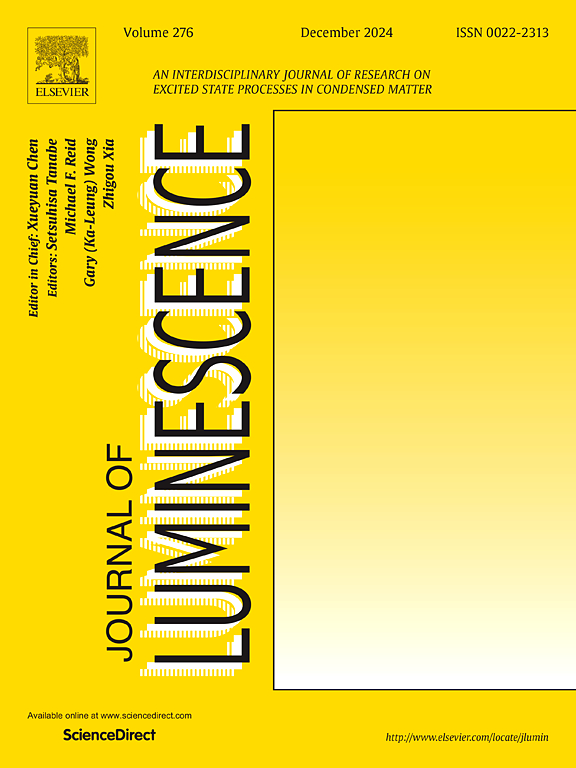设计具有异配体的发光Eu(III)配合物:光谱、DFT和Judd-Ofelt综合研究
IF 3.6
3区 物理与天体物理
Q2 OPTICS
引用次数: 0
摘要
本文探讨了设计发光镧系配合物的有效策略,重点是铕(Eu)配合物。以配体TFPD: 4,4,4-三氟-1-苯基-1,3-丁二酸酯和各种联吡啶衍生物:5,5′-二溴-2,2′-联吡啶(B1)、5-溴-5′-(2,3-二氢噻吩[3,4-b][1,4]二恶英-5-基]-2,2′-联吡啶(B2)和5,5′-双(2,3-二氢噻吩[3,4-b][1,4]二恶英-5-基)-2,2′-联吡啶(B3)合成了4个具有八坐标几何结构的Eu(III)配合物Eu(TFPD)3L。通过元素分析、红外和核磁共振光谱分析获得了结构信息,而光学和电化学研究揭示了有前途的带隙特性,将这些配合物定位为半导体应用的潜在候选者。在5D0→7F2跃迁的驱动下,Eu(III)配合物在光致发光分析中表现出强烈的红色发射,通过CIE 1931坐标验证了其准确性。此外,激发态寿命研究和Judd-Ofelt参数为Eu(III)离子周围的局部环境提供了有价值的数据,说明了中性配体在增强发光性能方面的作用。这项研究覆盖了Eu(III)配合物的定制发光方式,为先进的光学和电子应用开辟了新的可能性。本文章由计算机程序翻译,如有差异,请以英文原文为准。

Designing luminescent Eu(III) complexes with heteroligands: A comprehensive spectroscopic, DFT and Judd-Ofelt study
This research article explores effective strategies for designing luminescent lanthanide complexes, with a focus on europium (Eu) complexes. Four Eu(III) complexes, designated Eu(TFPD)3L, each with octa-coordinated geometry were synthesized using the ligand TFPD: 4,4,4- trifluoro-1-phenyl-1,3-butadionate and various bipyridine derivatives: 5,5ʹ-dibromo-2,2ʹ-bipyridine (B1), 5-bromo-5ʹ-(2,3-dihydrothieno[3,4-b][1,4]dioxin-5-yl]-2,2ʹ-bipyridine (B2) and 5,5ʹ-bis(2,3-dihydrothieno[3,4-b][1,4]dioxin-5-yl)-2,2ʹ-bipyridine (B3). Structural insights were gained through elemental analysis, IR and NMR spectroscopy, while optical and electrochemical studies revealed promising band gap properties, positioning these complexes as potential candidates for semiconducting applications. Eu(III) complexes exhibited intense red emission under photoluminescence analysis, driven by the 5D0→7F2 transition, with accuracy validated via CIE 1931 coordinates. Further, excited-state lifetime studies and Judd-Ofelt parameters provided valuable data on the local environment around the Eu(III) ions, illustrating the role of neutral ligands in enhancing luminescent properties. This study overlays the way for Eu(III) complexes with tailored luminescence, opening new possibilities for advanced optical and electronic applications.
求助全文
通过发布文献求助,成功后即可免费获取论文全文。
去求助
来源期刊

Journal of Luminescence
物理-光学
CiteScore
6.70
自引率
13.90%
发文量
850
审稿时长
3.8 months
期刊介绍:
The purpose of the Journal of Luminescence is to provide a means of communication between scientists in different disciplines who share a common interest in the electronic excited states of molecular, ionic and covalent systems, whether crystalline, amorphous, or liquid.
We invite original papers and reviews on such subjects as: exciton and polariton dynamics, dynamics of localized excited states, energy and charge transport in ordered and disordered systems, radiative and non-radiative recombination, relaxation processes, vibronic interactions in electronic excited states, photochemistry in condensed systems, excited state resonance, double resonance, spin dynamics, selective excitation spectroscopy, hole burning, coherent processes in excited states, (e.g. coherent optical transients, photon echoes, transient gratings), multiphoton processes, optical bistability, photochromism, and new techniques for the study of excited states. This list is not intended to be exhaustive. Papers in the traditional areas of optical spectroscopy (absorption, MCD, luminescence, Raman scattering) are welcome. Papers on applications (phosphors, scintillators, electro- and cathodo-luminescence, radiography, bioimaging, solar energy, energy conversion, etc.) are also welcome if they present results of scientific, rather than only technological interest. However, papers containing purely theoretical results, not related to phenomena in the excited states, as well as papers using luminescence spectroscopy to perform routine analytical chemistry or biochemistry procedures, are outside the scope of the journal. Some exceptions will be possible at the discretion of the editors.
 求助内容:
求助内容: 应助结果提醒方式:
应助结果提醒方式:


